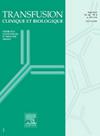儿童巨幼细胞性贫血的临床表现及病因分析。
IF 1.2
4区 医学
Q4 HEMATOLOGY
引用次数: 0
摘要
背景和目的:巨幼细胞性贫血(MA)是一种罕见的儿童病理,在大多数情况下,由于缺乏叶酸和/或维生素B12(钴胺素)。本研究旨在确定儿童MA的流行病学、临床和临床外概况,并明确其病因、治疗方式和治疗反应。方法:这是一项回顾性描述性研究,对1979年1月至2021年12月期间在斯法克斯Hedi Chaker大学医院普通儿科进行的42年儿童MA病例进行研究。我们纳入了所有16岁以下的骨髓显像显示巨幼细胞增生的患者。记录入选患者的人口学特征、体征、实验室结果和治疗反应。结果:共收集MA 20例,其中男11例,女9例。儿童MA发病率为0.014%。诊断时的中位年龄为3.37岁。临床表现为贫血综合征,面色苍白、虚弱。2例出现神经系统症状,10例出现消化系统疾病。7名婴儿有精神运动迟缓。入院时,所有患者均有贫血,平均值为5.6 g/dl。19例为大细胞性。白细胞减少(7例)、血小板减少(10例)、全血细胞减少(5例)。所有病例骨髓显像均为巨幼细胞增生,1例为铁母细胞。对5名患者进行了脑部核磁共振检查,其中3例显示异常。病因调查显示:继发于母体Biermer病(6例)、营养不良(3例)、Imerslund病(3例)、先天性转钴胺素II缺乏症(3例)、Biermer病(1例)、贾第虫病(1例)、继发于不良饮食摄入的叶酸缺乏症(1例)、线粒体细胞病合并维生素B12-叶酸缺乏症(1例)、Pearson综合征(1例)。我们的治疗包括对症治疗、替代治疗和病因治疗。11例有良好的进化。5名患者出现神经系统后遗症,1名患者死亡。结论:我们的研究强调了儿童MA病因背景的罕见性和异质性。早期诊断和治疗支持可以改善长期神经预后。本文章由计算机程序翻译,如有差异,请以英文原文为准。
Study of clinical manifestations and etiologies of megaloblastic anemia in children
Background and aim
Megaloblastic anemia (MA) is a rare pathology in childhood due, in the majority of cases, to a deficiency of folic acid and/or vitamin B12 (cobalamin). This study aims to determine the epidemiological, clinical, and paraclinical profiles of MA in children and to specify its etiologies, therapeutic modalities, and treatment responses.
Methods
This is a retrospective descriptive study of MA cases in children carried out in the General Pediatrics Department of the Hedi Chaker University Hospital of Sfax over a period of 42 years, from January 1979 to December 2021. We included all the patients under 16 years old with a myelogram showing megaloblastosis. The selected patients’ demographic characteristics, physical signs, laboratory findings, and treatment responses were recorded.
Results
Twenty cases of MA were collected, including 11 boys and 9 girls. The incidence of MA in children was 0.014%. The median age at diagnosis was 3.37 years. The clinical presentation was anemic syndrome with pallor and asthenia in all the cases. Neurological manifestations were noted in 2 cases and digestive disorders in 10 cases. Seven infants had psychomotor delays. On admission, all our patients had anemia with an average value of 5.6 g/dl. It was macrocytic in 19 cases. The blood count also revealed leukopenia (7 cases), thrombocytopenia (10 cases), and pancytopenia (5 cases). The myelogram showed megaloblastosis in all the cases and sideroblasts in one. A brain MRI was performed on five patients, and it showed abnormalities in three cases. The etiological investigations revealed a vitamin B12 deficiency secondary to a maternal Biermer’s disease (6 cases), malnutrition (3 cases), Imerslund’s disease (3 cases), congenital deficiency in transcobalamin II (3 cases), Biermer’s disease (1 case), giardiasis (1 case), folic acid deficiency secondary to a poor dietary intake (1 case), mitochondrial cytopathy with vitamin B12-Folic acid deficiency (1 case), and Pearson syndrome (1 case). Our treatment included symptomatic measures, replacement therapy, and etiological treatment. Favorable evolution was noted in 11 cases. Five patients had neurological sequelae, and one patient died.
Conclusion
Our study highlights the rarity and heterogeneity of the etiological contexts of MA in children. Early diagnosis and therapeutic support can improve the long-term neurological prognosis.
求助全文
通过发布文献求助,成功后即可免费获取论文全文。
去求助
来源期刊
CiteScore
2.50
自引率
11.80%
发文量
234
审稿时长
36 days
期刊介绍:
Transfusion Clinique et Biologique, the official journal of the French Society of Blood Transfusion (SFTS):
- an aid to training, at a European level
- the only French journal indexed in the hematology and immunology sections of Current Contents
Transfusion Clinique et Biologique spans fundamental research and everyday practice, with articles coming from both sides. Articles, reviews, case reports, letters to the editor and editorials are published in 4 editions a year, in French or in English, covering all scientific and medical aspects of transfusion: immunology, hematology, infectious diseases, genetics, molecular biology, etc. And finally, a convivial cross-disciplinary section on training and information offers practical updates.
Readership:
"Transfusers" are many and various: anesthetists, biologists, hematologists, and blood-bank, ICU and mobile emergency specialists...

 求助内容:
求助内容: 应助结果提醒方式:
应助结果提醒方式:


